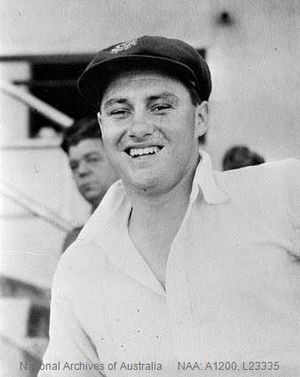Barry Jarman facts for kids

Jarman in 1957
|
||||||||||||||||||||||||||||||||||||||||
| Personal information | ||||||||||||||||||||||||||||||||||||||||
|---|---|---|---|---|---|---|---|---|---|---|---|---|---|---|---|---|---|---|---|---|---|---|---|---|---|---|---|---|---|---|---|---|---|---|---|---|---|---|---|---|
| Full name |
Barrington Noel Jarman
|
|||||||||||||||||||||||||||||||||||||||
| Born | 17 February 1936 Hindmarsh, South Australia |
|||||||||||||||||||||||||||||||||||||||
| Died | 17 July 2020 (aged 84) Adelaide, South Australia |
|||||||||||||||||||||||||||||||||||||||
| Height | 1.74 m (5 ft 9 in) | |||||||||||||||||||||||||||||||||||||||
| Batting | Right-handed | |||||||||||||||||||||||||||||||||||||||
| Role | Wicket-keeper | |||||||||||||||||||||||||||||||||||||||
| International information | ||||||||||||||||||||||||||||||||||||||||
| National side |
|
|||||||||||||||||||||||||||||||||||||||
| Test debut (cap 215) | 19 December 1959 v India | |||||||||||||||||||||||||||||||||||||||
| Last Test | 24 January 1969 v West Indies | |||||||||||||||||||||||||||||||||||||||
| Domestic team information | ||||||||||||||||||||||||||||||||||||||||
| Years | Team | |||||||||||||||||||||||||||||||||||||||
| 1955/56–1968/69 | South Australia | |||||||||||||||||||||||||||||||||||||||
| Career statistics | ||||||||||||||||||||||||||||||||||||||||
|
||||||||||||||||||||||||||||||||||||||||
|
Source: CricInfo, 19 July 2020
|
||||||||||||||||||||||||||||||||||||||||
Barrington Noel Jarman (born February 17, 1936 – died July 17, 2020) was a famous Australian Test cricketer. He also worked as a global cricket official called a match referee. Jarman played 19 Test matches for the Australian cricket team between 1959 and 1969. He even got to be captain for one of those games!
Contents
Early Life and Cricket Beginnings
Barry Jarman was born in Hindmarsh, South Australia. He went to Thebarton Technical High School. He started playing club cricket for Woodville Cricket Club.
He joined the club's schoolboy team when he was just 11 years old in 1948. By 1952, at age 15, he was already playing in the top-level "A-Grade" games.
Jarman also played Australian rules football when he was younger. He broke his leg while playing, which made him decide to focus completely on cricket.
Cricket Career Highlights
Jarman played his first big cricket match for South Australia in December 1955. He was selected for the Australian team touring New Zealand just over a year later.
He was chosen as one of two wicket-keepers for the 1957–58 tour of South Africa. However, another player, Wally Grout, became Australia's main wicket-keeper at that time.
Test Debut and Return to the Team
Jarman made his official Test debut in December 1959. This happened when Wally Grout was injured. He played against India in Kanpur.
After Grout recovered, Jarman became the reserve keeper again. He even went on a tour to England in 1961 but did not play in any Test matches.
Jarman returned to Test cricket when Grout broke his jaw. This was against England in Brisbane in 1962. He kept his spot until Grout was ready to play again.
Becoming First-Choice Wicket-Keeper
Jarman played Test cricket again during the 1964–65 tour of India. Here, he scored his highest ever Test score of 78 runs.
After Wally Grout retired in 1966, Jarman became Australia's main wicket-keeper. He played in important series against India, England, and the West Indies.
Captaincy and Retirement
In 1968, Jarman was made the vice-captain of the Australian team touring England. When the captain, Bill Lawry, injured his finger, Jarman got to lead Australia in one Test match.
Australia needed to draw the game to keep The Ashes trophy. They managed to do this, and Australia successfully held onto the trophy.
Jarman stopped playing cricket at the end of the 1968–69 series against the West Indies. He had played 19 Test matches in total. He scored 400 runs and caught 50 balls, plus made 4 stumpings.
In all his big matches (called first-class cricket), he scored 5,615 runs. He also caught 431 balls and made 129 stumpings. At the time, only two other Australians had better wicket-keeping records.
Life After Cricket
After retiring from playing, Barry Jarman stayed involved in sports. He worked in horse racing and cricket management.
In 1995, he became one of the first match referees for the International Cricket Council (ICC). In this role, he oversaw players and officials during international games. He was a referee for 53 international matches between 1995 and 2001.
In 1997, he received the Medal of the Order of Australia. This award was given to him for his great service to cricket as a player, coach, and international referee. It also recognized his work in horse racing in South Australia.
The main grandstand at the Woodville Oval in Adelaide is named the Barry Jarman Stand in his honor. This is where his old club, the Woodville Cricket Club, plays.
Barry Jarman was married to Gaynor and they had four children. He passed away on July 17, 2020, at the age of 84.


